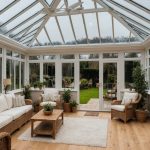Your garden's design plays a pivotal role in the water quality of your swimming pool. Choices such as plant selection, landscaping techniques, and drainage systems can either enhance or compromise clarity and sanitation. This synergy between nature and design offers a unique opportunity for UK homeowners to create a beautiful outdoor space that supports a clean pool environment. Understanding these connections empowers you to make informed decisions for a functional and aesthetically pleasing garden. Explore how thoughtful landscaping can lead to pristine waters, making your swimming experience enjoyable and refreshing.
The Relationship Between Garden Design and Swimming Pool Water Quality
Exploring the intricate connection between landscape and aquatic environments.
Dans le meme genre : Maximizing Rainwater Use: A Guide to Efficiently Powering Your UK Home Swimming Pool
Impact of Garden Design on Pool Water Quality
Garden design plays a pivotal role in maintaining swimming pool water quality. Thoughtful landscaping can either enhance or deteriorate the cleanliness of pool water. Selecting the appropriate plants and materials is crucial to prevent debris and contaminants from infiltrating the pool.
Key Landscaping Factors
Several factors in landscaping directly influence water quality:
En parallèle : How do you manage algae and mold in damp UK climates?
- Plant Selection: Opt for non-shedding plants to minimize debris.
- Material Choice: Use non-porous materials to reduce runoff.
- Drainage Systems: Ensure proper drainage to prevent soil erosion.
Importance of Plant and Material Selection
Choosing the right plants and materials can significantly impact the pool's ecosystem. Plants that shed excessively or attract insects can introduce unwanted elements into the water. Similarly, porous materials may contribute to runoff, carrying dirt and chemicals into the pool.
"A well-designed garden can be a pool's best friend, keeping the water clean and inviting."
By understanding the relationship between garden design and swimming pool water quality, homeowners can create a harmonious outdoor space that supports both aesthetic appeal and practical functionality. Prioritize smart landscaping decisions to enjoy a pristine pool environment.
Effective Garden Design Strategies for Maintaining Pool Water Quality
Implementing strategies to enhance both beauty and functionality in your outdoor spaces.
Techniques for Reducing Runoff and Pollution
Design strategies are essential for mitigating pollution and ensuring a clean swimming pool environment. One effective approach is the use of landscaping techniques that control water flow. Installing permeable surfaces, such as gravel pathways, can significantly reduce runoff by allowing water to seep into the ground rather than flowing into the pool.
Integrating Natural Filtration Systems
Integrating natural filtration systems into garden design is a sustainable method to maintain pool water quality. These systems, which can include constructed wetlands or bio-swales, utilize plants and soil to filter out pollutants naturally. This approach not only enhances the pool's ecosystem but also complements the garden's aesthetics.
Aesthetic Considerations
Aesthetic considerations in garden design should also serve functional purposes. For instance, strategically placed plants can act as windbreaks, reducing debris entering the pool. Here’s a list of dual-purpose elements:
- Native Plants: Require less maintenance and prevent soil erosion.
- Green Walls: Provide privacy and help absorb pollutants.
- Water Features: Enhance beauty and improve air quality.
"The art of garden design lies in balancing beauty with practicality, ensuring a serene and clean pool environment."
By employing these design strategies, homeowners can enjoy a visually appealing garden that actively supports pool water quality.
Best Plants for Enhancing Pool Water Quality
Discovering the right plants to improve your pool's ecosystem.
Overview of Beneficial Plants
Beneficial plants play a crucial role in enhancing pool water quality through natural water filtration. These plants not only beautify the surrounding landscape but also help filter out impurities. By choosing the right species, you can create a natural barrier that minimizes debris and pollutants entering your pool.
Specific Examples for UK Climates
For those in the UK, selecting plants that thrive in the local climate is essential. Consider these options:
- Lavender: Known for its low maintenance and ability to repel insects.
- Ferns: Excellent for shady areas and help absorb excess moisture.
- Grasses: Such as Carex, which are hardy and prevent soil erosion.
These plants are well-suited to the UK climate and contribute to effective landscaping choices.
Tips for Plant Placement
Strategic plant placement is vital for maximizing the benefits of your chosen flora. Here are some tips:
- Place grasses along the pool's edge to act as a natural filter.
- Use lavender in sunny spots to deter pests.
- Position ferns in shaded areas to maintain moisture balance.
"The right plants can transform your pool area into a natural oasis, enhancing both beauty and functionality."
Materials and Hardscaping for Better Water Management
Exploring the intersection of landscape design and water quality enhancement.
Types of Hardscaping Materials
Selecting the right hardscaping materials is essential for maintaining pool water quality. Non-porous options like concrete and stone pavers help minimize runoff, as they prevent water from seeping through and carrying debris into the pool. Additionally, permeable pavers can be strategically used to allow water infiltration, reducing surface runoff and promoting natural filtration.
Importance of Proper Drainage
Proper drainage solutions are vital in garden design to prevent water pooling and soil erosion. Installing French drains or channel drains can effectively redirect excess water away from the pool area. This not only protects the pool from contaminants but also preserves the integrity of the surrounding landscape.
Innovative Materials for Filtration
Innovative materials such as bio-retention soils and geotextiles enhance filtration and reduce pollution. These materials are designed to trap pollutants and facilitate water purification before it reaches the pool. By integrating these advanced options into your landscape design, you can significantly improve water management.
"The right combination of hardscaping materials and drainage solutions can transform your pool area into a sustainable and clean environment."
Employing these strategies ensures a harmonious balance between aesthetics and functionality in your outdoor spaces.
UK Regulations and Guidelines for Pool Water Quality
Understanding the legal landscape for maintaining pool environments.
Overview of Relevant Regulations
In the UK, regulations governing pool water quality are stringent, ensuring safe and healthy swimming environments. Key guidelines include standards set by the Pool Water Treatment Advisory Group (PWTAG), which provide comprehensive advice on maintaining optimal water conditions. These regulations impact garden design choices, as they dictate the permissible levels of chemicals and biological contaminants in pool water.
Compliance with Water Quality Standards
Adhering to water quality standards is crucial for pool owners to avoid legal repercussions and ensure user safety. Compliance involves regular testing and monitoring of water parameters, such as pH levels and chlorine concentration. Homeowners must integrate design elements that support these standards, such as effective drainage and filtration systems.
Resources for Homeowners
To navigate these regulations, homeowners can access various resources, including government publications and expert consultations. These resources offer guidance on implementing compliant garden designs that protect pool water quality.
- PWTAG Guidelines: Comprehensive standards for pool maintenance.
- Environmental Agency: Offers insights into sustainable practices.
- Local Councils: Provide specific regulations for regional compliance.
"Compliance with UK regulations ensures a safe and enjoyable swimming experience for all."
Case Studies: Successful Garden Designs Improving Pool Water Quality
Examining real-life examples to illustrate effective strategies.
Analysis of Real-Life Examples
Case studies offer valuable insights into how garden designs can enhance pool water quality. One notable example is a project in Surrey, where strategic plant selection and non-porous materials significantly reduced debris and runoff. This approach not only improved the pool's ecosystem but also maintained aesthetic appeal.
Another successful design in Kent integrated natural filtration systems, such as bio-swales, to manage water flow. The result was a cleaner pool environment with reduced chemical usage. These examples demonstrate the practicality of combining beauty with functionality.
Key Takeaways from Successful Projects
- Strategic Planting: Non-shedding plants minimize debris.
- Material Choice: Non-porous surfaces reduce runoff.
- Natural Filtration: Bio-swales enhance water quality naturally.
"Successful garden designs are those that harmonize with the environment, effectively improving pool water quality while maintaining visual appeal."
Visual Impact: Before and After
Visual transformations highlight the effectiveness of these designs. Before-and-after images reveal the stark contrast in water clarity and surrounding landscape. These case studies underscore the importance of thoughtful planning and execution in achieving sustainable outdoor spaces. By learning from these examples, homeowners can make informed decisions to enhance their own pool environments.
Maintenance Practices to Sustain Garden Design and Pool Quality
Ensuring longevity and effectiveness in your garden and pool environment.
Routine Maintenance Tips
Regular maintenance practices are essential for sustaining garden design and ensuring optimal water quality. Begin by scheduling routine inspections to identify and address potential issues early. Trim plants regularly to prevent overgrowth, which can contribute to debris entering the pool. Check drainage systems to ensure they remain clear and functional, reducing the risk of runoff.
Seasonal Care Best Practices
Adapting garden upkeep to seasonal changes is vital for maintaining water quality. In spring, focus on planting new flora and refreshing mulch to retain moisture. Summer requires vigilant watering and pest control to support plant health. During autumn, remove fallen leaves promptly to prevent them from decomposing and affecting pool chemistry. Winter is ideal for pruning and protecting sensitive plants from frost.
- Spring: Planting and mulching
- Summer: Watering and pest control
- Autumn: Leaf removal
- Winter: Pruning and protection
Monitoring and Adjusting Landscaping
To maintain ongoing effectiveness, regularly monitor your garden's impact on pool quality. Adjust plant placement or material choices if they contribute to contamination. Utilize soil tests to ensure nutrient balance, promoting healthy plant growth and reducing potential pollutants. By staying proactive, you can sustain a harmonious relationship between your garden and pool.
Visual Inspiration for Garden Designs Impacting Pool Water Quality
Exploring imaginative ideas to elevate your outdoor space.
Curated Examples of Garden Designs
Discover garden design inspiration that merges beauty with functionality, enhancing both aesthetics and water quality. Imagine a lush landscape where strategically placed native plants create natural barriers, minimizing debris while adding visual appeal.
Consider a garden adorned with green walls that not only provide privacy but also contribute to air purification, supporting a healthier pool environment. These designs demonstrate how thoughtful landscaping can transform your pool area into a serene retreat.
Visuals Illustrating Effective Design Strategies
Visual elements play a crucial role in conveying effective landscaping techniques. Picture a landscape with permeable pathways that blend seamlessly with the natural surroundings, reducing runoff and promoting water infiltration. Such visuals offer clear guidance on integrating practical solutions without sacrificing style.
Resources for Finding Additional Design Inspiration
For those seeking further inspiration, a wealth of resources is available. Explore local garden shows or consult with landscape architects specializing in eco-friendly designs. Utilize online platforms showcasing UK-specific landscaping ideas tailored to local climates and regulations.
"A well-designed garden is not just about aesthetics; it's about creating a space that nurtures both the environment and the soul."











